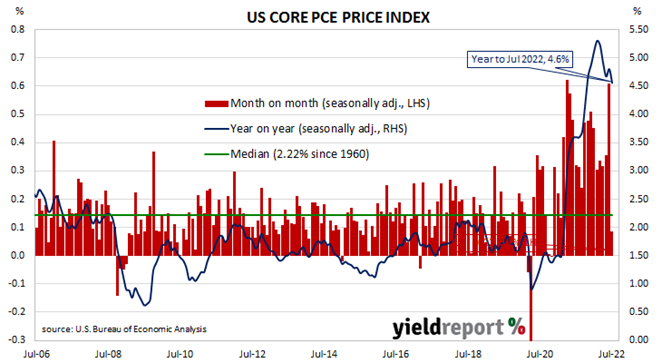Summary: US core PCE price index up 0.1% in July, in line with expectations; annual rate slows from 4.8% to 4.6%; US inflation remains too high, too early to declare victory; long-term Treasury yields down; more rate rises still expected.
One of the US Fed’s favoured measures of inflation is the change in the core personal consumption expenditures (PCE) price index. After hitting the Fed’s target at the time of 2.0% in mid-2018, the annual rate then hovered in a range between 1.8% and 2.0% before it eased back to a range between 1.5% and 1.8% through 2019. It then plummeted below 1.0% in April 2020 before rising back to around 1.5% in the September quarter of that year. It has since increased significantly above the Fed’s target.
The latest figures have now been published by the Bureau of Economic Analysis as part of the July personal income and expenditures report. Core PCE prices rose by just 0.1% over the month, in line with expectations but considerably less than June’s 0.6% increase. On a 12-month basis, the core PCE inflation rate slowed from June’s figure of 4.8% to 4.6%.
ANZ Head of Australian Economics David Plank said inflation over the last three months “remains too high”, even after including the latest figure, noting Fed chief Jerome Powell’s statement from Friday that “it’s far too early to declare victory.”
US Treasury bond yields fell on the day. By the close of business, 2-year and 10-year Treasury bond yield had both slipped 1bp to 3.38% and 3.04% respectively while the 30-year yield finished 4bps lower at 3.20%.
In terms of US Fed policy, expectations of a higher federal funds rate over the next 12 months firmed a little. At the close of business, September contracts implied an effective federal funds rate of 2.535%, 21bps higher than the current spot rate while November contracts implied a rate of 3.40%. September 2023 futures contracts implied 3.67%, 134bps above the spot rate.
The core version of PCE strips out energy and food components, which are volatile from month to month, in an attempt to identify the prevailing trend. It is not the only measure of inflation used by the Fed; the Fed also tracks the Consumer Price Index (CPI) and the Producer Price Index (PPI) from the Department of Labor. However, it is the one measure which is most often referred to in FOMC minutes.


